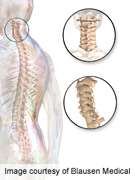In professional athletes, cervical spinal cord contusion may be due, in part, to congenital stenosis, the horizontal facet orientation of the cervical C3-C4 level, and the relative hypermobility of extension in this area, according to research published in the Feb. 15 issue of Spine.
(HealthDay)—In professional athletes, cervical spinal cord contusion may be due, in part, to congenital stenosis, the horizontal facet orientation of the cervical C3-C4 level, and the relative hypermobility of extension in this area, according to research published in the Feb. 15 issue of Spine.
Craig D. Brigham, M.D., and Jason Capo, M.D., of the OrthoCarolina, PA Spine Center in Charlotte, N.C., reported the results of a retrospective case series involving cervical spinal cord contusion in four professional athletes.
All four athletes exhibited congenital stenosis and signs and symptoms that did not correlate with the presence of a contusion due to hyperextension; all underwent anterior fusions at the level of their contusion. Two athletes developed new contusions, one between one and two years later at a new site and the other more than five years later at the same site. None of the four athletes developed permanent neurological sequelae.
"This supports the hypothesis that hypermobility and horizontal facet orientation contributes to this condition. Return-to-play criteria must be individualized and the specific cause of the concussion or contusion thoroughly investigated," the authors write. "Return-to-play decisions should prioritize an athlete's symptoms in context with appropriate imaging studies. Informed decision making regarding surgery and return to play should include realistic expectations of athletic goals. It should also be emphasized that the long-term sequelae of a cord contusion or repeated episodes of a cord concussion are unknown."
More information:
Abstract
Full Text (subscription or payment may be required)
Journal information: Spine
Health News Copyright © 2013 HealthDay. All rights reserved.




















